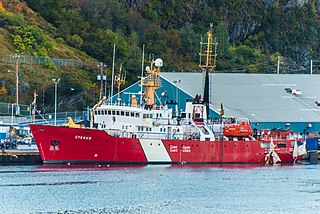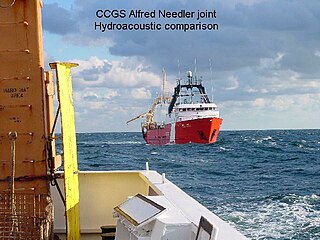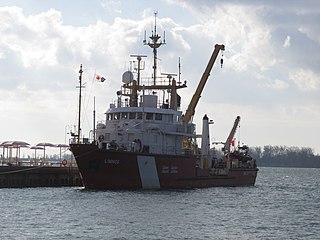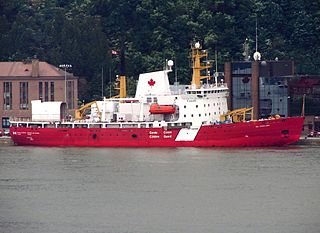
CCGS Samuel Risley is a Canadian Coast Guard icebreaker and buoy tender assigned to the Great Lakes area. Lead ship of her class, the vessel is named after Samuel Risley, the 19th century maritime inspector and first head of Board of Steamship Inspectors for Upper Canada and Ontario. Based in the Great Lakes, CCGS Samuel Risley is responsible for keeping an ice-free passage between Port Colborne, Ontario and Thunder Bay, Ontario.
CCGS Cape Roger is the lead ship of the Cape Roger-class fisheries patrol vessels operated by the Canadian Coast Guard. The ship entered service in 1977 and was assigned to monitor the Atlantic fisheries. During the Turbot War, Cape Roger took part in the detainment of the Spanish fishing trawler Estai. The ship is currently in service.

CCGS Frederick G. Creed was a hydrographic survey vessel operated by the Canadian Coast Guard on behalf of the Canadian Hydrographic Service, a scientific agency of the Department of Fisheries and Oceans. The ship was built in 1988 by Swath Ocean Systems Incorporated of San Diego, California and entered service the same year. The ship was taken out of service in March 2020 and sold for scrap.

CCGS Bartlett is a Provo Wallis-class buoy tender in operation by the Canadian Coast Guard. The vessel entered service in 1969 and was modernized in 1988. In 1982, the ship commanded the recovery efforts following the Ocean Ranger sinking off the coast of Newfoundland. The vessel is assigned to the Pacific Region and is based at Victoria, British Columbia.

CCGS Sir Wilfred Grenfell is a Canadian Coast Guard vessel based in Victoria, British Columbia. Designated an "Offshore Ice Strengthened Multi Patrol Vessel", the former offshore supply vessel is named after the medical missionary in Labrador, Sir Wilfred Grenfell. Constructed in 1984–1985, Sir Wilfred Grenfell was purchased by the Canadian Government and converted for Coast Guard service. In 1994, she played an important role in the fishing conflict known as the Turbot War in the Atlantic Ocean.

CCGS Leonard J. Cowley is an ice-strengthened fisheries patrol vessel of the Canadian Coast Guard. The ship entered service in 1984 and is still currently in service. During the Turbot War, the patrol vessel took part in the detainment of the Spanish fishing vessel Estai. Leonard J. Cowley's home port is St. John's, Newfoundland and Labrador.

CCGS Cygnus is a Cape Roger-class fisheries patrol vessel of the Canadian Coast Guard. The ship entered service in 1981 and is used to monitor the fisheries along the Atlantic coast of Canada. During the Turbot War, Cygnus was among the Coast Guard vessels sent to monitor the European fishing fleet on the Grand Banks.

CCGS Alfred Needler is an offshore fishery science vessel formerly operated by the Canadian Coast Guard. The vessel entered service in 1982 with the Department of Fisheries and Oceans, stationed at the Bedford Institute of Oceanography in Dartmouth, Nova Scotia. In 1995, in order to reduce the number of ships and combine tasks, the Fisheries and Oceans fleet and the Canadian Coast Guard fleets were merged under the Canadian Coast Guard. The ship was decommissioned from Canadian Coast Guard service in 2023.

CCGS W.E. Ricker was a Canadian Coast Guard offshore fisheries research vessel. The ship was originally constructed as the commercial fishing trawler Callistratus, but was purchased by the Government of Canada in 1984 and converted to a fisheries research vessel and renamed W.E. Ricker. The vessel entered service with the Department of Fisheries and Oceans in 1986 and was transferred to the Canadian Coast Guard in 1995 after the two fleets were amalgamated. The ship was assigned to the West Coast of Canada and was decommissioned on 14 March 2017.

CCGS Limnos is a Canadian Coast Guard coastal research and survey vessel and it is named after the Greek island of Limnos which itself derived from "limni", the Greek word for lake. The ship entered service in 1968 and is currently active. The ship is based on the Great Lakes at the Coast Guard Base in Burlington, Ontario and is used for hydrographic and limnological research.

CCGS Simcoe was a Canadian Coast Guard buoy tender and light icebreaker. The second vessel of the name in Canadian government service, Simcoe was in service from 1962 to 2007 based out of the Coast Guard base at Prescott, Ontario working the Great Lakes and Saint Lawrence Seaway. In 2008 the ship was sold to commercial interests.

CCGS Gordon Reid is an offshore fisheries patrol vessel of the Canadian Coast Guard. The vessel entered service in 1990 on the West Coast of Canada and is still in active service. In 2014, Gordon Reid responded to the distress signal of MV Simushur which had lost engine power off the coast of Haida Gwaii in British Columbia.
CCGS Wilfred Templeman was a Canadian Coast Guard fisheries research vessel that entered service 1981 with the Department of Fisheries and Oceans. In 1995 the Fisheries and Oceans and Canadian Coast Guard fleets were amalgamated and Wilfred Templeman joined the Canadian Coast Guard. The research vessel patrolled the coast off Newfoundland and Labrador. In 2011, the vessel was taken out of service, sold to commercial interests and renamed Blain M.

CCGS Vector is a hydrographic survey vessel in the Canadian Coast Guard. The ship was constructed in Canada and entered service in 1967 as a coastal research vessel on the West Coast. The ship is currently in service, based at Canadian Coast Guard Base Patricia Bay in Sidney, British Columbia.
CCGS Simon Fraser was a buoy tender operated by the Canadian Coast Guard. The vessel entered service in 1960 with the Department of Transport's Marine Fleet, before being transferred to the newly formed Canadian Coast Guard in 1962. The buoy tender served on both coasts of Canada and was used for search and rescue duties along the West Coast of Canada. The ship was loaned to the Royal Canadian Mounted Police in 2000 and transited the Northwest Passage, circumnavigating North America in the process. The ship was taken out of service in 2001 and sold to private interests. In 2006, the vessel reappeared as a yacht using the same name.
CCGS Provo Wallis is a Provo Wallis-class buoy tender that served with the Canadian Coast Guard. The vessel entered service in 1969 and was classed as a Medium-endurance Multi-tasked Vessel. Provo Wallis spent the majority of her career on the Atlantic Coast of Canada before transferring to the West Coast. Ice-strengthened, the ship was used mainly for maintaining navaids in shipping lanes. The vessel was taken out of service in 2011 and laid up.
CCGS J.E. Bernier was a Canadian Coast Guard medium Arctic icebreaker with a steel hull. The vessel was in service from 1967 to 2006. The ship was initially based at Quebec City but finished her career at St. John's. The ship was named for Joseph-Elzéar Bernier, captain of CGS Arctic which explored and monitored the eastern Arctic for the Government of Canada in the early 20th century. The vessel was sold in 2006 to private interests.

The Samuel Risley-class icebreakers are a class of two icebreakers and buoy tenders constructed for and operated by the Canadian Coast Guard. The two ships are based on offshore supply tugboat design and entered service in the 1980s. Samuel Risley is deployed to the Central Region, operating mainly on the Great Lakes of North America, while Earl Grey is posted to Atlantic Canada, working off the east coast of Canada.

CCGS Tanu is a fisheries patrol vessel in service with the Canadian Coast Guard. The ship was constructed in 1968 by Yarrows at their yard in Esquimalt, British Columbia and entered service the same year. Home ported at Patricia Bay, British Columbia, the ship is primarily used to carry out fisheries patrols and search and rescue missions along Canada's Pacific coast.

The Pierre Radisson-class icebreakers, also known as R-class icebreakers, are a class of four icebreakers constructed for and operated by the Canadian Coast Guard. The Canadian Coast Guard designates the four ships in the class as medium icebreakers. Built in two phases, the first three ships, Pierre Radisson, Franklin and Des Groseilliers, were built to a common design. The fourth, Henry Larsen was built to a modified design and is considered a subclass, the Improved R-class icebreaker. Franklin was later renamed Sir John Franklin before undergoing a re-design for use primarily as an Arctic research vessel. Upon the vessel's return to service, the ship was once again renamed Amundsen. All the vessels are named for people who sailed through Canada's northern waters. The class operates in the Arctic Ocean in the summer, patrolling, icebreaking and research missions.















